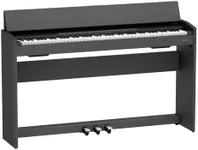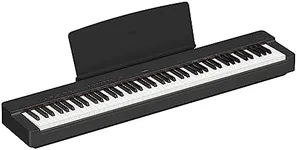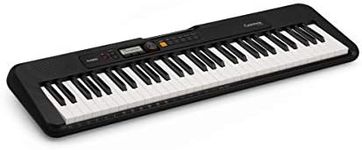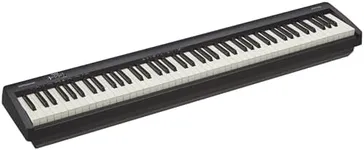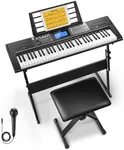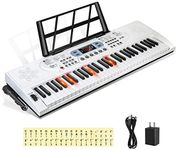Buying Guide for the Best Beginner Piano Keyboard
Choosing a beginner piano keyboard can be an exciting step towards learning music. The right keyboard will make your learning process smoother and more enjoyable. When shopping, focus on features that support learning and comfort, rather than advanced functions you might not need yet. Think about where and how you’ll use the keyboard, and what will keep you motivated to practice. Understanding the key specifications will help you make a choice that fits your needs and learning style.Number of KeysThe number of keys on a keyboard determines how many notes you can play at once and the range of music you can perform. Full-sized pianos have 88 keys, but beginner keyboards often come with 61 or 76 keys. A 61-key keyboard is lighter and more portable, making it easier for young learners or those with limited space, but it may limit you as you progress to more complex pieces. A 76-key keyboard offers a wider range and is a good middle ground. If you plan to eventually play classical or advanced music, starting with 76 or 88 keys is ideal, but for casual learning and pop songs, 61 keys are usually enough.
Key Action (Touch Sensitivity and Weighted Keys)Key action refers to how the keys feel and respond when you press them. Weighted keys mimic the feel of an acoustic piano, making it easier to transition to a real piano later, while unweighted keys are lighter and easier for beginners. Touch sensitivity means the keyboard responds to how hard or soft you press the keys, allowing for more expressive playing. For beginners, touch-sensitive keys are helpful for learning dynamics, but fully weighted keys are not always necessary unless you are serious about classical piano. If you want a more authentic piano feel, look for at least semi-weighted or touch-sensitive keys.
Built-in Learning FeaturesMany beginner keyboards come with built-in learning tools like light-up keys, lesson modes, or apps that guide you through songs. These features can make learning more engaging and help you practice more effectively. If you are teaching yourself or want extra support, look for keyboards with these features. However, if you have a teacher or prefer traditional learning, you may not need as many built-in lessons.
Portability and SizePortability is about how easy it is to move and store your keyboard. Lighter, more compact keyboards are easier to carry and fit into small spaces, which is great if you need to move your keyboard often or have limited room. Larger keyboards with more keys or built-in stands are heavier and take up more space, but they can feel more stable and closer to a real piano. Think about where you’ll play and store your keyboard to decide what size and weight will work best for you.
Sound Quality and PolyphonySound quality refers to how realistic and pleasant the keyboard sounds. Polyphony is the number of notes the keyboard can play at once; higher polyphony allows for more complex music without notes dropping out. For beginners, basic sound quality and polyphony (32 or 64 notes) are usually enough, but if you want richer sounds or plan to play layered music, look for higher polyphony and better sound samples. Try listening to demo sounds if possible to see if you like how the keyboard sounds.
Connectivity OptionsConnectivity options include headphone jacks, USB ports, and MIDI connections. Headphone jacks let you practice quietly, while USB or MIDI ports allow you to connect to computers or learning apps. If you want to record your playing, use music software, or practice without disturbing others, make sure the keyboard has the right connections for your needs.
